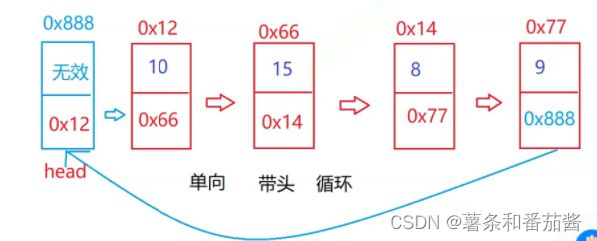数据结构——链表(java)
文章目录
- 链表
-
- 1. 基本介绍
-
- 1.1 定义
- 1.2 链表分类
- 3.不带头非循环单链表CURD
- 4.不带头非循环双向链表CURD
链表
1. 基本介绍
1.1 定义
链表是一种物理存储结构上非连续存储结构,数据元素的逻辑顺序是通过链表中的引用链接次序实现的。
1.2 链表分类
单向、双向;带头、不带头;循环、非循环
重点:单向不带头非循环、双向不带头非循环(集合类底层)
如图:单项带头非循环链表结构

如图:单向带头循环链表结构

如图:双向不带头循环链表结构

3.不带头非循环单链表CURD
代码展示:
package demo3;
/**
* @author zq
* 不带头非循环单链表相关操作
*/
public class MySingleList {
class Node {
public int val;//存储数据
public Node next;//存储下一个节点地址
public Node(int val) {
//不知道下一个节点位置,只需要val
this.val = val;
}
}
public Node head;//代表当前头节点的引用
//遍历链表
//创建链表
public void createLink(){
Node node1 = new Node(12);
Node node2 = new Node(45);
Node node3 = new Node(23);
Node node4 = new Node(90);
node1.next = node2;
node2.next = node3;
node3.next = node4;
head = node1;
}
//遍历链表,利用head遍历链表
public void display() {
while (head != null){
System.out.println(head.val);
head = head.next;
}
}
//查找是否包含关键字key是否在单链表当中
public boolean contains(int key){
Node cur = head;
while (cur != null){
if (cur.val == key){
return true;
}
cur = cur.next;
}
return false;
}
//头插法
public void addFirst(int data){
Node node = new Node(data);
node.next = head;
head = node;
}
//尾插法,需判断head是否为空
public void addLast(int data){
Node node = new Node(data);
if (head == null) {
head = node;
return;
}
Node cur = head;
while (cur.next != null) {
cur = cur.next;
}
cur.next = node;
}
//任意位置插入,第一个数据节点为0号下标
public void addIndex(int index,int data){
checkindex(index);
if (index == 0){
addFirst(data);
return;
}
if (index == size()){
addLast(data);
return;
}
Node cur = findIndexSubOne(index);
Node node = new Node(data);
node.next = cur.next;
cur.next = node;
}
/*
找到index-1处的节点
*/
private Node findIndexSubOne(int index){
Node cur = head;
int count = 0;
while (count != index -1 ){
cur = cur.next;
count++;
}
return cur;
}
private void checkindex(int index){
if (index<0||index>size()){
throw new IndexOutOfException("index位置不合法");
}
}
//删除第一次出现关键字为key的节点
public void remove(int key){
if (head.val == key){
head = head.next;
return;
}
Node cur = searchPrev(key);
if (cur == null){
return;
}
cur.next = cur.next.next;
}
//删除所有值为key的节点
public void removeAllKey(int key){
if (head == null){
return;
}
//如果前俩个节点值均为key时。
// 或者用if放到最后,直接删掉漏掉的节点
while (head.val==key){
head = head.next;
}
Node prev = head;
Node cur = head.next;
while (cur != null){
if (cur.val == key){
prev.next = cur.next;
cur = cur.next;
}else{
prev = cur;
cur = cur.next;
}
}
}
//找到关键字key的前一个节点
private Node searchPrev(int key){
if (head== null){
return null;//链表为空时
}
Node cur = head;
while (cur.next!= null){
if (cur.next.val == key){
return cur;
}
cur = cur.next;
}
return null;//没有需要删除的节点
}
//得到单链表的长度
public int size(){
int count = 0;
Node cur = head;
while (cur != null){
count++;
cur = cur.next;
}
return count;
}
/*
保证列表中每一个节点都被回收
*/
public void clear() {
ListNode cur = head;
while(cur != null){
ListNode curNext = cur.next;
cur.prev = null;
cur.next = null;
cur = curNext;
}
head = null;
last = null;
}
}
4.不带头非循环双向链表CURD
代码展示:
package demo4;
import demo3.MySingleList;
import java.util.List;
/**
* @author zq
* LinkedList的实现
* 双向链表
*/
public class MyLinkedList {
static class ListNode{
ListNode prev;
ListNode next;
int val;
public ListNode(int val) {
//不知道下一个节点位置,只需要val
this.val = val;
}
}
public MyLinkedList.ListNode head;//代表当前头节点的引用
public MyLinkedList.ListNode last;//代表最后节点的引用
//头插法
public void addFirst(int data){
ListNode node = new ListNode(data);
if (head == null) {
head = node;
last = node;
}else{
node.next = head;
node.prev = null;
head.prev = node;
head = node;
}
}
//尾插法
public void addLast(int data){
ListNode node = new ListNode(data);
if (head == null){
head = node;
last = node;
}else{
last.next = node;
node.prev = last;
node.next = null;
last = node;
}
}
//任意位置插入,第一个数据节点为0号下标
public void addIndex(int index,int data){
ListNode node = new ListNode(data);
checkindex(index);
if (index==0){
addFirst(data);
return;
}
if (index==size()){
addLast(data);
return;
}
ListNode cur = findIndex(index);
node.next = cur;
cur.prev.next = node;
node.prev = cur.prev;
cur.prev = node;
}
//判断插入位置是否合法
private void checkindex(int index){
if (index<0||index>size()){
throw new IndexOutOfException("index位置不合法");
}
}
/*
找到index处的节点
*/
private ListNode findIndex(int index){
ListNode cur = head;
while (index != 0){
cur = cur.next;
index--;
}
return cur;
}
//查找是否包含关键字key是否在单链表当中
public boolean contains(int key){
ListNode cur = head;
while(cur != null){
if (cur.val == key){
return true;
}
cur = cur.next;
}
return false;
}
//删除第一次出现关键字为key的节点
public void remove(int key){
ListNode cur = head;
while (cur != null) {
if (cur.val == key) {
//删除的是头节点
if(cur == head) {
head=head.next;
//如果只有一个节点时处理方式
//否则会有空指针异常
if (head !=null) {
head.prev = null;
}
}else{
//中间,尾巴都能用此行代码。
cur.prev.next = cur.next;
if (cur.next != null){
//不是尾巴节点
cur.next.prev = cur.prev;
}else {
last = cur.prev;
}
}
return;
}
cur = cur.next;
}
}
//删除所有值为key的节点
public void removeAllKey(int key){
ListNode cur = head;
while (cur != null) {
if (cur.val == key) {
//删除的是头节点
if(cur == head) {
head=head.next;
//如果只有一个节点时处理方式
//否则会有空指针异常
if (head !=null) {
head.prev = null;
}
}else{
//中间,尾巴都能用此行代码。
cur.prev.next = cur.next;
if (cur.next != null){
//不是尾巴节点
cur.next.prev = cur.prev;
}else {
last = cur.prev;
}
}
}
cur = cur.next;
}
}
//得到单链表的长度
public int size(){
int len = 0;
ListNode cur = head;
while (cur != null){
cur = cur.next;
len++;
}
return len;
}
public void display(){
ListNode cur = head;
while (cur !=null){
System.out.print(cur.val + " ");
cur = cur.next;
}
}
public void clear(){
head = null;
}
}
